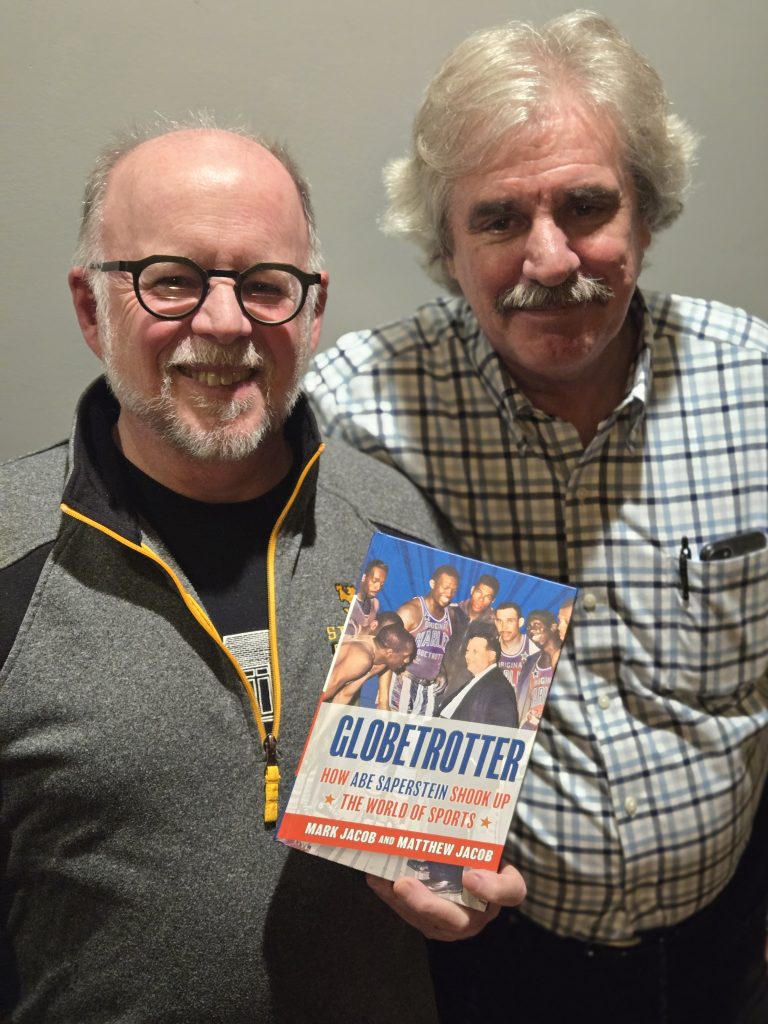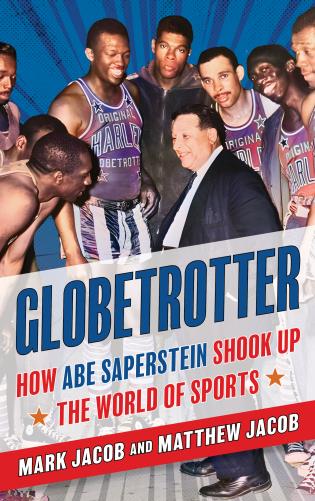Abe Saperstein was the founder and owner of the Harlem Globetrotters, a tireless showman, promoter and scout. In addition to helping popularize and integrate pro basketball, he made a huge contribution to integration and baseball as well. Journalist Mark Jacob, along with his brother Matt, recently published a biography of Saperstein, who (no surprise when you think about it) was good friends with Bill Veeck and Satchel Paige. Today and next Sunday, Mark and Matt Jacob will discuss this dynamic and how Saperstein was instrumental in getting Satchel Paige to the major leagues. (Part 2 of 2)
Q: Saperstein had a special relationship with the great pitcher Satchel Paige. Tell us about that.
Saperstein recognized that Paige’s pitching talent and instinct for showmanship made him a box-office draw, so he booked Paige for many non-league barnstorming games and special appearances. When Saperstein was scheduling Black teams for barnstorming tours, he designated Paige as an “individual proposition,” which meant the host venue had to pay extra if Paige was pitching that game.
Near the end of Paige’s career, Saperstein was the guy who got him into Major League Baseball – finally – at the age of 42. This was in 1948, the season after Jackie Robinson broke the color barrier. Saperstein was talking with his friend Bill Veeck, then owner of the Cleveland Indians, about how the team had a lot of potential but was weak in the bullpen. Saperstein suggested the Indians sign Paige, but Veeck’s front office was highly skeptical. So Saperstein brought Paige in for a tryout, and his performance sold the Indians on the idea. Though some observers thought the signing was a publicity stunt, Paige performed well and was one reason the Indians won the World Series that season.

Though he loved basketball, and occasionally donned a uniform when needed in the early years of the Globetrotters, Abe Saperstein stood at only 5 feet 3 inches.
Q: Obviously, Saperstein valued Paige. But did Paige value Saperstein?
Paige called him “Abraham Lincoln-stein” and praised the “real big money” that Saperstein helped him earn on tour. Saperstein, of course, took a healthy cut too. We’ve determined that in the early 1940s Paige was baseball’s highest paid pitcher, Black or white. In 1942, Saperstein arranged games in three cities pitting a Black team, anchored by Paige, against an all-white squad led by pitcher Jay Hanna “Dizzy” Dean. Dean once said that a team with Paige and him on its roster would “clinch the pennant mathematically by the Fourth of July and go fishin’ until the World Series.”
Q: Did Saperstein and Paige have a long-term relationship?
Saperstein began helping build the Paige brand in the early ‘30s. Here’s one example: Saperstein recruited Paige and other Black players in 1933 to join white semi-pro teams in North Dakota—a state with 377 Black residents out of roughly 681,000 total residents. An auto dealer who owned the Bismarck team asked Saperstein to recommend “the greatest colored pitcher in baseball today,” and Saperstein arranged for Paige to join his team. The pitcher got to use the fanciest cars from the owner’s Chrysler dealership, as long as he was not seen “riding white girls around in broad daylight.” Paige was such a hit that when he returned to play for the Bismarck club in 1935, Saperstein got him a contract for $8,600 in salary and fringe benefits—more than seven times the per capita income of Americans at that time.

Saperstein was an enabler when Paige broke business agreements, as he did frequently. Saperstein was an enabler when Paige broke business agreements, as he did frequently. Paige’s 1933 stint in North Dakota was an example. Paige began the season pitching for the Pittsburgh Crawfords, but in early August, Saperstein told him about the Bismarck opportunity. Paige walked out on his agreement with the Crawfords, infuriating team owner Gus Greenlee.
Paige’s biographer wrote that he “would walk out on more signed contracts than any player in history. When he came back it was generally on even richer terms than before.” In his autobiography, Paige wrote that he didn’t feel bad about “jumping contracts when I felt like it.” One team owner told Paige he would offer him the shortest contract in baseball: “No show, no dough.”
Q: Paige and Saperstein were both masters of publicity, correct?
They both said outlandish and highly quotable things. Saperstein once persuaded the Associated Press to run a story that the Globetrotters were bringing a kangaroo back from Australia to play basketball with the team. Of course, they didn’t suit up a kangaroo — it was a joke. Saperstein sometimes got press by floating ideas for kooky basketball rule changes. For example, he suggested that the backboard be curved so that rebounds were less predictable, reducing the advantage of tall players. And he wanted to move the baskets 15 feet from the baseline into the court and remove the backboards altogether, allowing players to shoot from behind the basket and supposedly giving more players opportunities to get rebounds. Neither idea went anywhere, except into the pages of newspaper sports sections. (Saperstein did pioneer the three-point shot in the 1960s when he founded his own basketball league, but was unable to convince the NBA to adopt the change. The rule died with Saperstein’s league in 1962. When the ABA began in 1967, the three-point shot was introduced, but Saperstein had no connection with that league.)

Paige was famous for sayings like “Don’t look back. Something might be gaining on you.” He explained his pitching success by saying: “I eat only fried foods.” When Paige was asked how old he was, he said he didn’t know because his birth date was written in his family’s Bible and a goat ate the Bible.
Q: Did Saperstein get other Black ballplayers into the major leagues?
Three of the first eight Black ballplayers who broke the color barrier were recommended by Saperstein. There was Paige, of course, but first there was outfielder Larry Doby, who also signed with the Cleveland Indians and was the first Black player in the American League. Then came Minnie Miñoso, who was signed by the Indians but gained fame with the Chicago White Sox. All three players – Paige, Doby, and Miñoso – are in the Baseball Hall of Fame. Saperstein isn’t, but perhaps the hall should consider him.
For more on Mark and Matt and Globetrotter, check out this profile from the Chicago Tribune’s Rick Kogan. For Part 1 of this interview, click here.
Order Globetrotter: How Abe Saperstein Shook Up the World of Sports from your local bookstore or from Amazon.


